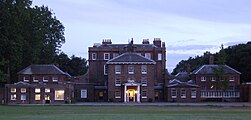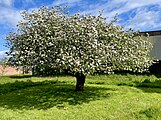Bushy House
| Bushy House | |
|---|---|
National Physical Laboratory | |
| Design and construction | |
| Architect(s) | William Samwell |
Listed Building – Grade II* | |
| Official name | Bushy House |
| Designated | 2 September 1952 |
| Reference no. | 1080870 |
Bushy House is a
had constructed for his own enjoyment on the site of a previous house Upper Lodge, Bushy Park, between 1714 and 1715.It is part of the
The ground floor and basement levels of Bushy House were converted to laboratory space and
History
Bushy House in its first form was built in 1663 by William Samwell for Edward Proger, at a cost of £4,000 (£773,000 in 2023),[2] as the lodge of the Keeper/Ranger of Bushy Park in what was at the time the North Park part. Proger had been made Ranger of Bushy Park to reward him for his loyalty to King Charles II during his exile.[3]
It was rebuilt by the
In 1797, after the death of both Lord North and his wife,
In 1865, Queen Victoria offered Bushy House to the Prince Louis, Duke of Nemours and other members of the exiled French royal family as they tried to restore the House of Bourbon. After his return to France in 1871, he kept control of Bushy House until his death in 1896 in case he was forced to leave France again, and with Nemours not having children as heirs, the house became empty in 1897.
In March 1902, the new National Physical Laboratory was opened at Bushy House by the Prince of Wales (later
Gallery
-
North side of Bushy House in 2007
-
Bushy House from an 1827 book illustration
-
East side of Bushy House in 1901/1902
-
A clone of Isaac Newton's apple tree
References
- ^ Historic England (2 September 1952). "Bushy House (1080870)". National Heritage List for England. Retrieved 27 July 2020.
- ^ UK Retail Price Index inflation figures are based on data from Clark, Gregory (2017). "The Annual RPI and Average Earnings for Britain, 1209 to Present (New Series)". MeasuringWorth. Retrieved 7 May 2024.
- ^ a b c Spelthorne Hundred: Hampton Court Palace, parks' in A History of the County of Middlesex: Volume 2, ed. William Page (London, 1911), pp. 386-388. British History Online Retrieved 1 October 2017.
- ^ a b c Google Books
The Story of Dorothy Jordan
Armstrong, Clare & Jerrold, Bridgman
Ayer Publishing, 1969
ISBN 978-0-405-08672-4
- ^ "The National Physical Laboratory". The Times. No. 36720. London. 20 March 1902. p. 6.
Sources
- Eileen Magnello (2000). A Century of Measurement. Canopus. ISBN 0-9537868-1-1.
- The Story of Bushy House




